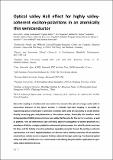Files in this item
Optical valley Hall effect for highly valley-coherent exciton-polaritons in an atomically thin semiconductor
Item metadata
| dc.contributor.author | Lundt, Nils | |
| dc.contributor.author | Dusanowski, Łukasz | |
| dc.contributor.author | Sedov, Evgeny | |
| dc.contributor.author | Stepanov, Petr | |
| dc.contributor.author | Glazov, Mikhail | |
| dc.contributor.author | Klembt, Sebastian | |
| dc.contributor.author | Klaas, Martin | |
| dc.contributor.author | Beierlein, Johannes | |
| dc.contributor.author | Qin, Ying | |
| dc.contributor.author | Tongay, Sefaattin | |
| dc.contributor.author | Richard, Maxime | |
| dc.contributor.author | Kavokin, Alexey | |
| dc.contributor.author | Höfling, Sven | |
| dc.contributor.author | Schneider, Christian | |
| dc.date.accessioned | 2020-01-22T00:35:07Z | |
| dc.date.available | 2020-01-22T00:35:07Z | |
| dc.date.issued | 2019-07-22 | |
| dc.identifier | 259077834 | |
| dc.identifier | 2ed11988-eb97-4a04-92be-1b52bb9456b9 | |
| dc.identifier | 000478794700016 | |
| dc.identifier | 85070198041 | |
| dc.identifier.citation | Lundt , N , Dusanowski , Ł , Sedov , E , Stepanov , P , Glazov , M , Klembt , S , Klaas , M , Beierlein , J , Qin , Y , Tongay , S , Richard , M , Kavokin , A , Höfling , S & Schneider , C 2019 , ' Optical valley Hall effect for highly valley-coherent exciton-polaritons in an atomically thin semiconductor ' , Nature Nanotechnology . https://doi.org/10.1038/s41565-019-0492-0 | en |
| dc.identifier.issn | 1748-3387 | |
| dc.identifier.uri | https://hdl.handle.net/10023/19330 | |
| dc.description | C.S. acknowledges support by the ERC (Project unLiMIt-2D). The Würzburg group acknowledges support by the State of Bavaria. A.V.K. acknowledges the support from Westlake University (Project No. 041020100118). E.S. acknowledges support from the President of the Russian Federation for state support of young Russian scientists Grant No. MK-2839.2019.2 and the RFBR Grant No. 17-52-10006. S.K. acknowledges support by the EU (Marie Curie Project TOPOPOLIS). Q.Y. and S.T. acknowledge funding from NSF DMR-1838443 and DMR-1552220. M.M.G. acknowledges partial support from RFBR Project 17-02-00383. | en |
| dc.description.abstract | Spin–orbit coupling is a fundamental mechanism that connects the spin of a charge carrier with its momentum. In the optical domain, an analogous synthetic spin–orbit coupling is accessible by engineering optical anisotropies in photonic materials. Both yield the possibility of creating devices that directly harness spin and polarization as information carriers. Atomically thin transition metal dichalcogenides promise intrinsic spin-valley Hall features for free carriers, excitons and photons. Here we demonstrate spin- and valley-selective propagation of exciton-polaritons in a monolayer of MoSe2 that is strongly coupled to a microcavity photon mode. In a wire-like device we trace the flow and helicity of exciton-polaritons expanding along its channel. By exciting a coherent superposition of K and K′ tagged polaritons, we observe valley-selective expansion of the polariton cloud without either an external magnetic field or coherent Rayleigh scattering. The observed optical valley Hall effect occurs on a macroscopic scale, offering the potential for applications in spin-valley-locked photonic devices. | |
| dc.format.extent | 7 | |
| dc.format.extent | 1071316 | |
| dc.format.extent | 823798 | |
| dc.language.iso | eng | |
| dc.relation.ispartof | Nature Nanotechnology | en |
| dc.subject | QC Physics | en |
| dc.subject | NDAS | en |
| dc.subject.lcc | QC | en |
| dc.title | Optical valley Hall effect for highly valley-coherent exciton-polaritons in an atomically thin semiconductor | en |
| dc.type | Journal article | en |
| dc.contributor.institution | University of St Andrews. Condensed Matter Physics | en |
| dc.contributor.institution | University of St Andrews. School of Physics and Astronomy | en |
| dc.identifier.doi | https://doi.org/10.1038/s41565-019-0492-0 | |
| dc.description.status | Peer reviewed | en |
| dc.date.embargoedUntil | 2020-01-22 |
This item appears in the following Collection(s)
Items in the St Andrews Research Repository are protected by copyright, with all rights reserved, unless otherwise indicated.


